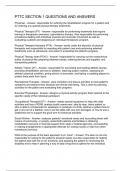Semester 01
L.Smith
(67337163)
,Contents
1. TOPIC 1 – Quantitive Methods in Research Psychology ................................................................................ 3
1.1 Quantitive Research in Psychology ................................................................................................................. 4
1.2 Constructs as the Building Blocks of Theories ............................................................................................... 4
1.3 How Constructs are made visible through Measurement ............................................................................. 4
1.4 Collecting Info by Sampling Data ..................................................................................................................... 5
1.5 The Research Hypothesis [RH] ........................................................................................................................ 7
SUMMARY OF TOPIC 1.......................................................................................................................................... 8
2. TOPIC 2 – Probability ........................................................................................................................................... 9
2.1 Intro to the Study of Probability ....................................................................................................................10
2.2 Discrete Probability Distribution & The Binominal Distribution ...............................................................13
2.3 Continuous Probabilities & The Normal Curve ............................................................................................17
2.4 Sampling Distributions & The Central Limit Theorem ................................................................................21
SUMMARY OF TOPIC 2........................................................................................................................................24
3. TOPIC 3 – General Principles of Statistical Hypothesis Testing ................................................................26
3.1 Translating a Research Hypothesis into a Statistical Hypothesis ...............................................................27
3.2 Using Data from a Sample to Calculate the Probability of a particular Result ...........................................28
3.3 Making a Decision regarding the Null & Alternative Hypothesis ................................................................30
4. TOPIC 4 – Statistical Hypothesis Testing: Testing Means for a Single Sample .......................................34
4.1 Comparing a single mean to a constant value ..............................................................................................35
4.2 Testing a single mean when the population standard deviation is unknown ...........................................36
5. TOPIC 5 – Statistical Hypothesis Testing: Comparing Two Samples ........................................................38
5.1 Testing for differences between the means of two independent groups ...................................................39
5.2 Testing for differences between the means of two dependent groups ......................................................41
5.3 Using differences scores to compare two independent groups ..................................................................42
6. TOPIC 6 – Testing Hypotheses about a Relationship Between Two Variables .......................................45
6.1 Correlation: Measuring the association between variables ........................................................................46
6.2 A test of association between two nominal variables: the χ2 test contingency tables ..............................51
GLOSSARY & ABBREVIATIONS .............................................................................................................................55
LIST OF SYMBOLS ....................................................................................................................................................58
LIST OF FORMULAS.................................................................................................................................................59
LIST OF HELPFUL VIDEO LINKS ............................................................................................................................62
SUMMARY PYC3704 – Psychological Research [L.Smith 67337163] Page 1
, Notes:
Defined terms are highlighted in yellow and definitions are indicated with a *
Info obtained from the internet are in italics, incl. the {internet source}
Abbreviations are indicated in square brackets [Abbr.]
To insert the mean symbol (µ) in Word use Alt+m
To insert the x̅ symbol in Word type an x then use Alt+0773
To insert the square root symbol (√) in Word use Alt+251
{https://synergycodes.com/blog/3-steps-to-conduct-your-research-easier/}
SUMMARY PYC3704 – Psychological Research [L.Smith 67337163] Page 2
, 1. TOPIC 1 – Quantitive Methods in Research
Psychology
{https://www.researchoptimus.com/blog/qualitative-vs-quantitative-research/}
SUMMARY PYC3704 – Psychological Research [L.Smith 67337163] Page 3










